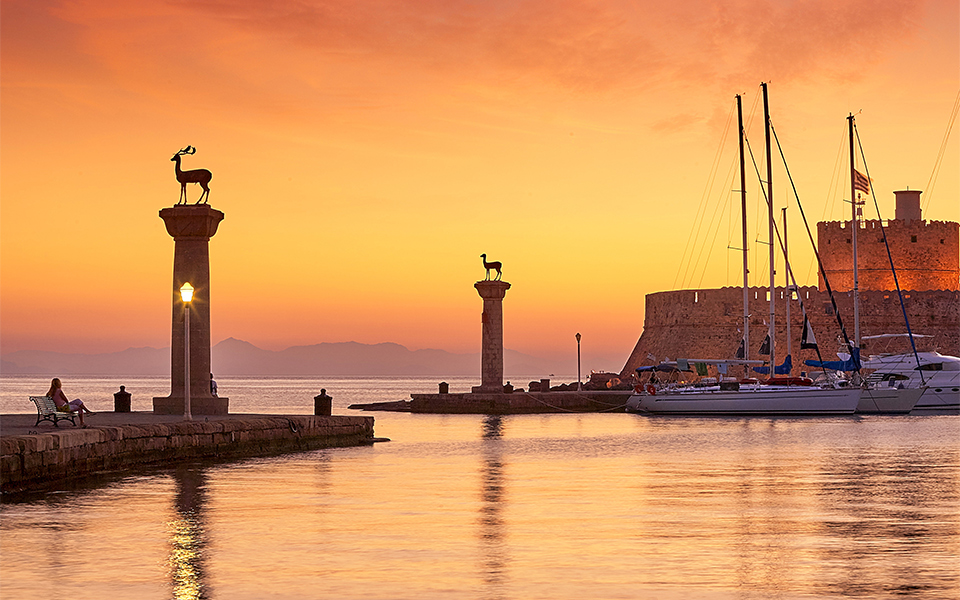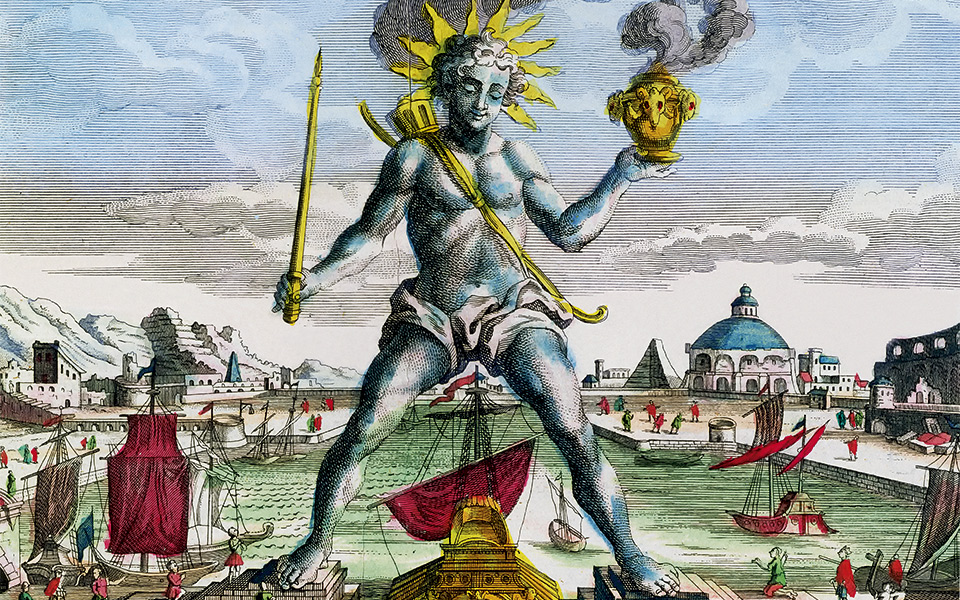For more than fifty years in the 3rd c. BC, visitors to Rhodes were treated to a view of one of the ancient world’s “Seven Wonders”: a gigantic bronze statue of Helios, god of the sun, hailed as the Colossus of Rhodes. Although physical traces of this masterwork have all nearly vanished, the story of the statue lives on, intertwining historical conflict, colorful characters, artistic ingenuity and enduring controversy.
After Alexander the Great’s death in 323 BC and while his rivalrous successors struggled against one another for power and lands, Antigonus I Monophthalmus (“The One-Eyed”) sent his son, Demetrius I Poliorcetes (“The Besieger”), to attack Rhodes in 305-304 BC, hoping to force the island to break its ties with Ptolemaic Egypt. When the siege failed, due to Rhodes’ strong defenses and the Egyptians’ clandestine provisioning of the island, Ptolemy I became known as Soter (Savior), a name given to him by the Rhodians.
To defeat the Rhodians, Poliorcetes had employed a full array of weaponry and equipment, including an enormous rolling siege tower, called a Helepolis (“City Destroying”) that was 40m high and 20m wide. The sides of this multi-storied machine were iron-plated. Openings in the plating allowed the firing of catapults and dart-throwers. Nevertheless, unintimidated, the Rhodians resisted and ultimately either forced the Helepolis’ withdrawal or caused it to become bogged down in ground covertly softened.
Giving up after a year-long siege, Poliorcetes departed Rhodes, abandoning his machines and many of his weapons – which the Rhodians promptly sold to finance the construction of a giant victory monument-cum-offering to their primary divine patron, Helios.

Chares of Lindos, a pupil of Lysippus, created the Colossus of Rhodes, taking twelve years to complete it at a cost of 300 gold talents – equivalent today to several million dollars. Historical sources give various heights for the Colossus (60-80 cubits). The average of these sources puts it at the same height (about 34m) as New York’s Statue of Liberty (not including her upraised arm). The ancient text, “On the Seven Wonders of the World,” ostensibly provides further details concerning the Colossus, but its author (“Philo of Byzantium”) – regardless of his eloquence (Chares “…made a god to equal the god, and…by his daring…had given the world a second sun to match the first…”) – has been shown to be later in date (3rd-4th c. AD) and unreliable as a source.
How Chares crafted the Colossus, therefore, with cast or hammered sections of bronze, remains a mystery. Iron braces were likely employed for internal reinforcement, but still the statue proved short-lived, ultimately collapsing during an earthquake in 226 BC. Noting its size, hollowness and construction, Pliny wrote: “Few men can clasp the thumb in their arms, and its fingers are larger than most statues. Where the limbs are broken asunder, vast caverns are seen yawning in the interior. Within it, too, are to be seen large masses of rock, by the weight of which the artist steadied it…”
Where the Colossus stood also remains a question. Medieval artists depict it astride the entrance to Rhodes’ port, one foot on the terminus of each breakwater. Technical considerations would have made this location impossible, but a distinctive circle of stones and finely-carved marble blocks reused in the 15th c. St. Nicholas Tower at the mouth of Mandraki harbor may indicate the base and position of the statue there. Alternatively, the Rhodian acropolis has also been proposed as a possible location.
The actual appearance of the Colossus poses further questions. A Rhodian relief, according to Andrew Stewart, suggests a figure resembling the Getty’s bronze Victorious Youth (300-100 BC). Furthermore, a special series of silver Rhodian didrachms depict the head of Helios with a rayed crown, which may have represented and paid homage to the newly erected Colossus. After the Colossus collapsed, the Rhodians followed oracular advice from Delphi and chose not to rebuild their monument. The fallen remains themselves became a tourist attraction; in the 7th c. AD, they were sold by the island’s Muslim overlords to a merchant from Edessa. Today, a debate rages in debt-torn Greece whether a new Colossus of Rhodes should be erected.












